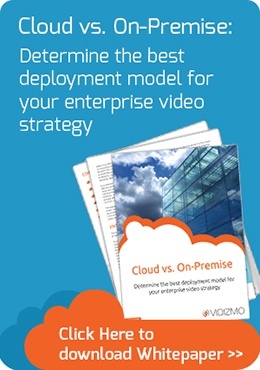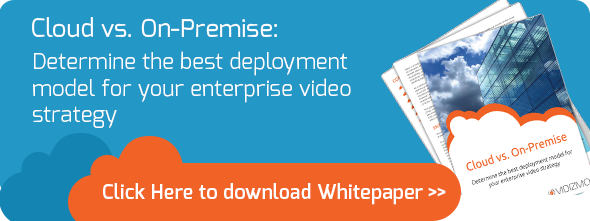Organizations around the world are adopting the cloud to harness its potential for scalability, agility, cost savings, and innovation. Cloud computing offers new ways to implement ready-made IT infrastructure and services flexibly availed on an on-demand basis -- saving businesses time and money spent to build costly data centers and hiring IT teams to manage them.
In addition, the cloud offers scalable data storage capacities, global accessibility, reliability of backup and disaster recovery, specialized media services and business intelligence solutions, as well as highly sophisticated security and compliance standards.
However, even with its myriad benefits, cloud may not be fitting for every organization or every kind of workflow. Following are some of the scenarios that might deem on-premise more suitable than cloud.
Too big for the cloud
Modern-day companies that are born in public cloud sometimes deploy their own datacenter on-premises overtime because the value for money attained from cloud sometimes declines as the company gets bigger. In such a case of diminishing marginal return, organizations then need to evaluate whether the cloud is still as economically beneficial as it was when they first started out. With increase economies of scale, companies have to assess their performance viability and determine if an in-house infrastructure may be a better option that also grants them greater control and predictability over cost, security, and performance.
While public cloud storage may be cheaper per TB, the cost can add up for high capacity points or long retention times, resulting in much higher overall expenses. Moreover, businesses also need to pay attention to all extra fees charged for commonly recurring tasks like accessing and restoring data, for example, tasks that on-premise users are free to run as they please, without fear of sticker shocks upon receiving the cloud vendor’s invoice.
Also, a rising trend for hardware financing or renting colocation space means that an on-premise infrastructure can now be treated as an operational expense as opposed to a capital expense—which is one of the biggest motivating factors for some companies to move to the cloud in the first place.
In addition, an on-premises infrastructure may also give companies a more predictable yearly costing than cloud. This is because on-premise installations are usually on annual or multi-year plans, eliminating the need for monthly fees. Cloud pricing, on the other hand, can result in a higher overall price tag for unforeseen price increases for things like extra storage or higher than expected consumption of bandwidth.
Not only this, but cloud users might also be susceptible to hidden costs for outbound bandwidth (egress) costs in case of data migration from the cloud, automatic features enhancement or upgrades resulting in frequent price increase, as well as free services that are billable after reaching a threshold.
Too regulated for the cloud
Organizations operating in heavily regulated industries such as finance, healthcare, retail, transportation, and government have meticulously stringent policies involving data security, compliance, privacy, and ownership, which necessitates that business-critical operations be held closer to the user and controller base.
Companies that handle sensitive information, such as those in the financial or healthcare industry, for example, are not only legally obligated to hold their data in-house but may also need regular access to their data backup. In such cases, companies simply don’t have the option to use the cloud as it lacks compliance with specialized policies or industry-specific guidelines, making it an unsuitable candidate for firms operating in heavily regulated sectors.
Too specialized for the cloud
Firms that operate within highly specialized industries require greater customizability to accommodate unique business demands while others might have proprietary systems or applications that are challenging to integrate with the cloud. Firms with complex information management guidelines or restrictions also find that cloud is not flexible enough for their situation.
In on-premise deployments, businesses enjoy the greatest flexibility to make custom software deployments and configurations for applications and systems. In comparison, cloud-based customization options are often rigid and limited to a-la-carte options that come at a steep price, adding significantly to the overall cost. Customized solutions offered by mega-cloud vendors like Microsoft and IBM are also extremely costly and require companies to hire a consultant or implementation specialist.
Custom security needs
Even with enormous improvements in cloud security and sophistication, security continues to be a legitimate determining factor while choosing to store data on-premise. Firms in specialized industries are required to maintain industry-specific security guidelines, which in turn necessitates the need for sophisticated customizations that are simply not achievable with the cloud.
On-premise installations, on the other hand, grant robust security standards customized based on an individual organization's processes, requirements, security, compliance and regulatory standards. Moreover, as data resides solely on on-premises servers with robust in-house security and compliance standards, all data access is restricted on-site for every system, application, and database, fortifying security as per the company’s specific security and privacy needs and requirements.
Existing infrastructure and migration costs
For long-established firms with dense on-premises architecture, it is sometimes imprudent not to leverage those resources to evolve technologies in-house, perhaps by using a hybrid cloud scenario. Most banks, for example, have extensive legacy IT structures which can be transformed in a hybrid cloud to get the same agility and cost effectiveness of the cloud combined with the value of on-premises setups to avail the best of both worlds.
Additionally, an already secure and reliable in-house infrastructure renders a move to the cloud counterproductive as it amounts to greater spending just for the sake of moving to the cloud. Also, companies must analyze the range of data systems that need to be moved to the cloud because cloud migration cost may be too high for excessive workloads. If a business’ requirement can be met at a lesser cost than setting up an internal network then a move to the cloud may not be viable.

County of Los Angeles Utilized VIDIZMO On-Premise Video Streaming to Keep Their Data Secure - Read More on This Story
Contact us to know more about VIDIZMO Enterprise Video Content Management System and our deployment models in the cloud, on-premises and model or sign up for our free 30-day trial to explore the platform today.
Posted by Shahan Zafar
Shahan is the Product Marketing Manager at VIDIZMO - An expert in video streaming, sharing and management platforms. Shahan is actively involved in researching and consolidating information regarding innovative features, customer challenges and emerging trends in this domain. You can email at websales@vidizmo.com for any queries.





